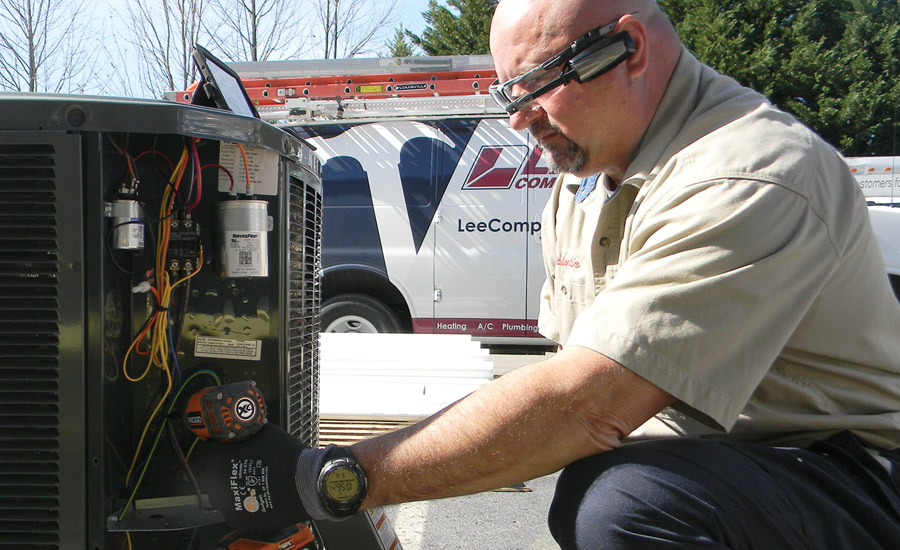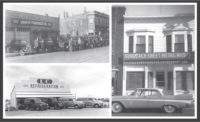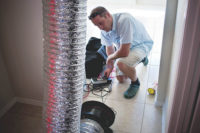HVAC contractors nationwide are struggling to locate and hire qualified technicians. And, while many complaints have been uttered, not everyone is actively trying to solve the problem.
One Midwestern HVAC company is using cutting-edge technology to view this epidemic from another angle.
Lee Co., a Franklin, Tennessee-based facility and home-services company with more than 1,000 employees, recently outfitted each of its commercial field technicians with smart glasses that they can use to make video calls to the office for support as well as record videos for customers.
“Techs are getting harder to find, and we’ve got skilled-labor issues in our country, so we’ve got to figure out how to do more with fewer people,” said Steve Scott, vice president of facilities solutions at Lee Co. “We’re not trying to replace or eliminate people — we just recognize 40 percent of skilled trades labor in our country is eligible to retire within the next 10 years.”
As Lee Co.’s leadership team discussed this problem, Scott said the company began researching ways to use technology to enable growth in spite of the technician shortage. The company turned to wearable technology, or smart glasses, that are connected to the cloud in ways designed to provide value to both technicians and customers. For example, a junior field technician wearing the smart glasses can place a video call to a senior technician at the office and ask for immediate help with a question or concern on a jobsite. On his computer screen in the office, the senior technician can see what the field technician is looking at and provide the mentoring and advice needed — as if he were right there on site. (It’s such a compelling scenario that Lee Co. has posted a YouTube video of it.)
Following a successful pilot program, company management issued 150 pairs of smart glasses to its technicians in January, which was among the largest roll-out of wearable technology across an enterprise, according to the smart glass providers. And, although Lee Co. may be the first, it won’t be the last. Aaron Salow, CEO of XOEye Technologies, said other HVAC companies across the country are currently piloting their own smart glass programs.
MERGING SERVICE AND TECHNOLOGY
Lee Co. has been in business for 73 years while XOEye Technologies, located in Nashville, Tennessee, is approaching its third anniversary. Yet, these two Tennessee-based companies have partnered to integrate smart glasses into the HVAC field service industry. When Lee Co.’s team started talking to XOEye, Scott said the company found the technology-driven missing link they’d been looking for to build their service platform.
Salow said his company is focused on blue-collar verticals, including HVAC companies. XOEye develops custom software applications that are loaded on wearable devices and connected to its cloud-based platform, Vision.
The goal behind XOEye’s software, Salow explained, is to enable companies to securely gather visual intelligence that can become “actionable data.” In other words, it’s important to XOEye that companies are able to use the vast amounts of videos and pictures that are created by employees using smart glasses.
Currently, the company is developing applications for the Vuzix M100, a durable model of smart glasses made in Rochester, New York. The Vuzix M100 glasses are comparable to the more widely-known Google Glass, though Salow said Vuzix glasses are tough enough to be used in the field, adding, they’re built to withstand extreme impacts, like when a tech drops them onto a concrete floor.
Scott continued to explain that, while Vuzix is “more behind-the-scenes,” XOEye Technologies has been involved in every step of Lee Co.’s transition to the new technology. Lee Co. and XOEye held many combined brainstorming sessions to ultimately develop a customized software application just for the HVAC field service technician.
“If we’re making technology that makes it tough for field personnel, they will find ways not to use it,” Salow said.
To combat this, the smart glasses are tied into technicians’ everyday workflow. Describing the typical workflow, Salow said that when technicians arrive at a job site, they will first take a few on-site photos and potentially take a short video explaining what they see. All of these files will be uploaded to the service ticket. Next, technicians have the option of watching a training video or recording their own work to be used as a future training video. If technicians run into any problems, they can place a telepresence call to Lee Co.’s triage center and ask for help from “the guys and gals who have seen it all,” Salow explained. For the final step, technicians record a recap video for the customer that explains the service that was provided.
“We actually have scripts for the guys,” Salow said. “They’re getting better and better at it over time, and it provides a level of transparency for the customer.”
BUILDING SECURITY INTO THE CLOUD
While customers may appreciate being able to see exactly what technicians have done in their facilities, the creation of so many images and videos brings with it concerns about privacy and security.
“We knew we needed to vet this out because it was totally foreign to our people and our industry,” Scott said. “During the pilot process, we were also spending time with customers and talking to them about this platform.”
According to Salow, security is of paramount importance to XOEye in order to protect both technicians and customers.
“When you capture content with a set of safety glasses, that content is immediately streamed to a private cloud that’s only accessible for parties that the company wants that [data to be] accessible to,” Salow said. “We have mobile device management procedures in place that allow us to protect that information.”
Content recorded on the smart glasses cannot be downloaded by the user, although the device can store information locally when there is no Internet connection available.
“Even then, you can’t pull the information off,” Salow said. “Once it hits a Wi-Fi signal again, it will upload to the cloud.”
Salow said these security measures are great selling points for smart glasses. Some companies say the hands-free aspect of the glasses is nice, but their technicians can already use their phones and tablets to capture data. However, when technicians use their phones and tablets to record data, Salow noted, they can send that information to anyone. In contrast, his software gives customers confidence that their data is secure and protected, he said.
Plus, the smart glasses aren’t supposed to make technicians feel like Big Brother is hovering over them, he added.
“You cannot access a live feed without the user accepting or making a telepresence call,” Salow said. “We’ve actually made it impossible for the technology to just auto-answer. Technicians have to accept and confirm the call for it to come in.”
CONNECTING THE FIELD AND OFFICE
Gaining the support and acceptance of technicians has been a vital component to Lee Co.’s adoption of smart glasses. The company tested the smart glasses exhaustively with a pilot program before issuing them to technicians.
Jomi Holt, field technician at Lee Co., has been in the HVAC industry for 19 years. He participated in the pilot program and said the biggest benefit so far has been the ability to give customers the chance to see what he sees in the field.
As the company’s testing continued, Scott said other technicians began asking when they would get to use the new glasses, too. Of course, there is a learning curve associated with any new technology, and Lee Co. has really focused on supporting his team members who are donning the glasses in the field.
“Some of the guys have had a little bit of difficulty trying to figure out the technology, how to use it, how to care for it, and how to make it function under normal working circumstances,” Holt said.
Wayne Ashworth, who has more than 30 years of HVAC industry experience, is transitioning to a brand-new role at Lee Co. — triage center technician. Currently, Ashworth spends a lot of time reviewing the videos and messages technicians are recording on-site to help improve the quality of their presentations to customers.
“Primarily, my work is in the office in support of the people using the units in the field,” Ashworth said.
Both Ashworth and Holt said connectivity remains the biggest challenge as Lee Co. continues to incorporate the new technology. In locations where cell phones can’t get a signal, it’s impossible for smart glasses to connect and send video, which limits the glasses’ effectiveness. But, since improving cellular networks is out of Lee Co. and XOEye’s control, they are focused on what they can do to get the most from the technology.
Out in the field, Holt is using the smart glasses every day. During a recent preventive maintenance inspection, he took a few short videos and pictures of items he thought needed to be addressed. One clip spotlighted water that was leaking onto an electrical disconnect. After the customer looked through the batch of videos, he got back in touch with Holt and said he wanted the leak fixed, since it had been causing him even bigger problems in an office adjacent to the mechanical room.
“I found out after talking with him that not only was the water coming in and getting on the disconnect, but it was also getting into an office that was adjacent to the mechanical room. [The customer] had dealt with multiple problems over the years with water getting into the office and soaking the carpet, but he never could figure out where it was coming from,” Holt explained. “Just being able to see the problem and knowing the facility like he does, he was able to instantly put two and two together.”
Although it was a small repair, it was a big deal to the customer, said Holt.
“With a five-dollar tube of silicone, I was able to go out there and seal the spot where the leak was occurring. Not only did it take care of the issue as far as keeping water off the electrical disconnect, but it also fixed the water-leak problem that was in the office,” Holt said.
SEEING A BRIGHT FUTURE
Overall, the smart glasses are bringing a new level of visibility and transparency to HVAC field work, Scott said. Following the rollout of smart glasses to Lee Co.’s commercial technicians, the company is now piloting the use of smart glasses with its residential technicians.
Salow also said his company is working with other HVAC service contractors who are interested in adopting smart glasses for techs.
Looking back, Scott said, “Five years ago we were like most companies; we had paper tickets, were dispatching like everybody else, and sent support when somebody got stumped on a job.”
Now, Scott’s excited Lee Co. is striving to stay relevant and move ahead of the problems facing the HVAC industry.
“When we’re sitting here looking at ways we can grow or expand, you have to have people to be more efficient or use technologies to close that gap,” he said. “That was the driver for me, to try to really take the responsibility of continuing to create a sustainable business that continues to offer our employees a place to work so that we don’t just become dated, and we can’t perform this because people aren’t available.”
Publication date: 4/18/2016
Want more HVAC industry news and information? Join The NEWS on Facebook, Twitter, and LinkedIn today!







